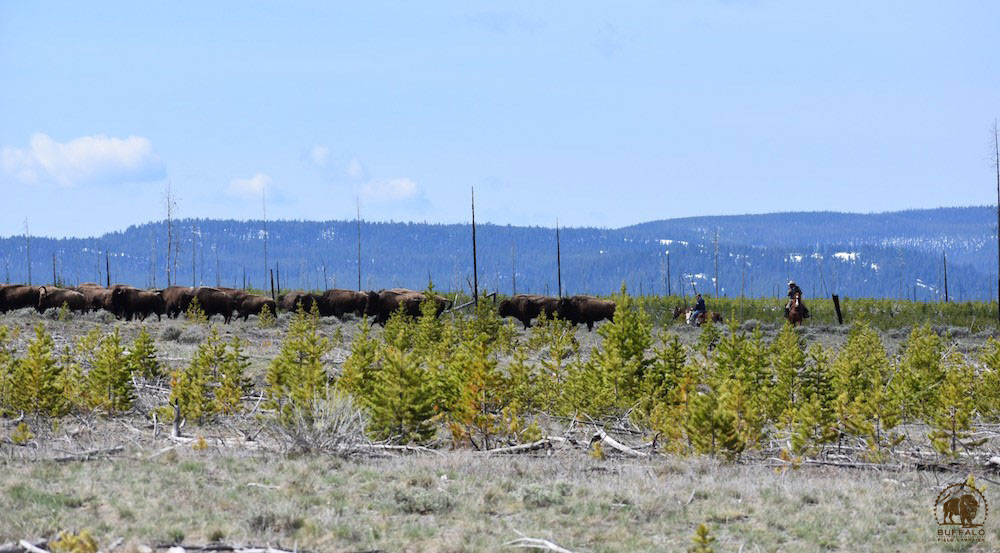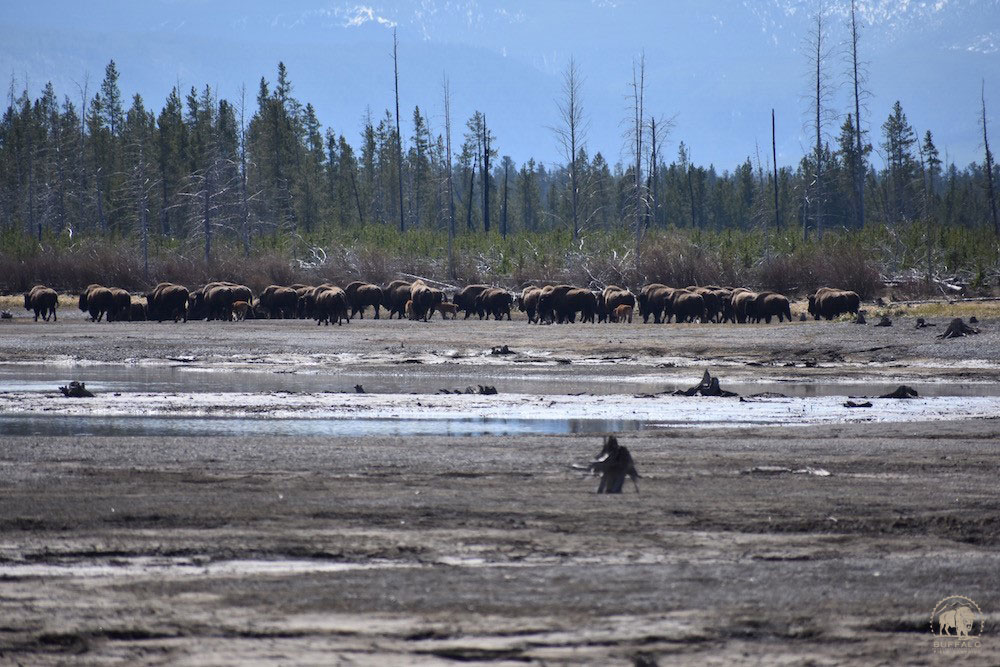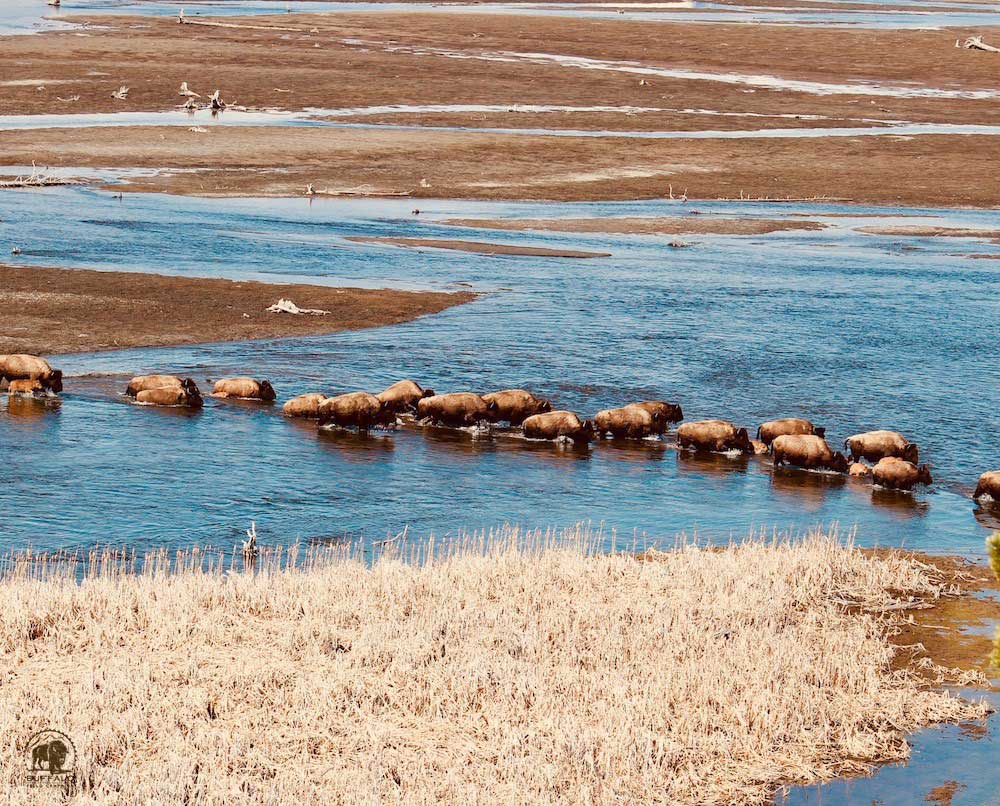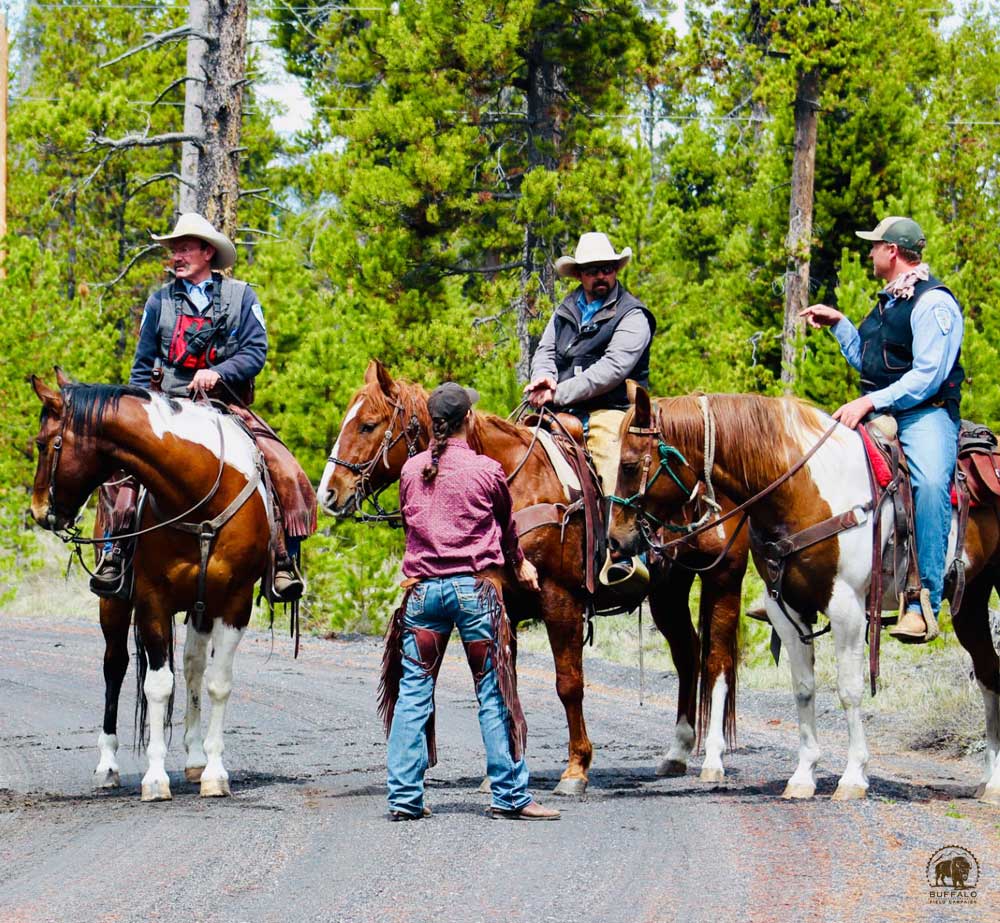Approximately 80 buffalo including about 30 calves flee hazers on the Gallatin National Forest. Photo by Stephany Seay, Buffalo Field Campaign.
The south side of the Madison River within the Gallatin National Forest is a tenuous place for wild buffalo. Only a few buffalo are allowed to be in certain portions of this part of the Gallatin National Forest for a few short months of the winter, then when the Interagency Bison Management Plan’s May 15th deadline arrives, no buffalo are allowed there at all. In other words, the south side of the Madison River was not included in the year-round habitat wild buffalo gained. This south side habitat is enormous, with miles of grasses, sage brush, lodgepole forest, and shoreline. There are never any cattle on this part of the Forest, so there is absolutely no reason that wild buffalo should not be left in peace there.
Over the weekend, a few buffalo were spotted by BFC patrols and we feared they would soon be targets for MT Department of Livestock harassment. Then, on Wednesday, the morning of the imminent haze, nearly 100 buffalo including at least 30 newborn calves, were spotted in this “no tolerance zone.” Our patrols were ready. Our Duck Creek patrol was monitoring the arrival of the hazers, our rove patrol was with the buffalo, and our stand by patrol was ready to go wherever they were needed. The hazers and their law enforcement back up represented the Montana Department of Livestock, USDA’s Animal & Plant Health Inspection Service, Montana Department of Fish, Wildlife & Parks, and the National Forest Service. As expected, horsemen and stock trailers with horses, along with state and federal law enforcement, began to gather. By ten o’clock, the hazers were heading out to harass the gentle giants, forcing them off of public land where no cattle ever graze.
Buffalo flee along the water’s edge, avoiding thicker mud to find an easier river crossing for their babies. Photo by Stephany Seay, Buffalo Field Campaign.
These buffalo have been through such hazing operations more times than anyone cares to remember. As soon as the hazers unloaded and mounted their horses, all of the buffalo who had been relaxing and grazing, got up and ran. It only took them one look at the riders to know trouble was coming. The hazers never really got to haze those buffalo until it was almost over, because the buffalo just took off, with horses barely keeping up. The buffalo ran through thick deadfall and crowded baby lodgepole trees, down towards the muddy flats of the Madison River. They attempted to cross at one spot, but the mud was so thick, they knew their babies would have too tough a time, so they ran further along the shore to where the mud was less challenging and the water of the river was shallow. As they tried to drink water and rest at the shore, the horses caught up and forced the herd across the river. The buffalo swam, babies staying close to their moms. Coming up on the other side of the river, they continued on heading up the Northwest Bluffs where they are allowed to be, and were finally able to rest, graze, an nurse. Some of these buffalo headed west towards Horse Butte, while the majority of this group meandered towards the busy US Highway 191. As a direct result of the hazing operation, scores of wild buffalo occupied the dangerous highway as they made their way towards the relative shelter of Yellowstone National Park. The agents who were responsible for this never bothered to warn traffic. Luckily, our stand by patrol was with the buffalo and able to put up our Buffalo On Road signs to help warn the many cars and semis speeding through this corridor.
Buffalo cross the Madison River, heading towards the bluffs where they are safe from harassment by hazers. Photo by Roman Sanchez, BFC Board of Directors.
Unfortunately, hazing was not yet over for the day. The hazers knew about another small group of buffalo — six with one tiny calf -- and they were determined to find them. The riders loaded up their horses and headed deeper into the Forest where they found the family. But, they weren’t going to get to haze these buffalo either. After the hazers unloaded their horses, the buffalo took off through the thick lodgepole, losing the agents. After some time looking for them, they found a fraction of the group. Two of the riders had broken off, and the two who were with these five buffalo were at a stand off. The buffalo weren’t budging. Nearly an hour went by before the other two riders arrived, and they attempted to resume the haze. Again, the buffalo were not going to cooperate. The buffalo bolted through the trees and down to the river, the agents nowhere near them, and they crossed through Houdini’s Meadow, swimming the Madison River near Chipmunk’s Overlook. Up the bluffs and on towards Horse Butte they went, where they are safe from such bullies.
“Um, which way did they go?” Department of Livestock and APHIS hazers search for, but never find, a small group of buffalo they were aiming to harass. Photo by Roman Sanchez, BFC Board of Directors.
Today, the hazers returned. They wanted to find the three buffalo who had broken off from the smaller group the day before. Our rove patrol found them and were with them, but the agents never did find them. They were offered fresh tracks to follow, but, these guys know very little about wild buffalo. Obvious clues right in their faces, they chose different paths than what the buffalo had taken. By lunchtime, the hazers had given up for the day. The buffalo remain where they choose to be. These harmful and unnecessary actions — paid for with your federal tax dollars — are some of the many reasons that we need to gain Species of Conservation Concern status for wild, migratory buffalo in the Gallatin National Forest’s plan revision. You can help make that happen by submitting comments in support of strengthening Alternative D with enforceable standards for American bison. You can make the most impact by individualizing or writing comments in your own words. You can find a lot of helpful information including a draft of BFC’s comments, on our species of conservation concern web page.
Thank you for everything you do for wild buffalo!
WILD IS THE WAY ~ ROAM FREE!




